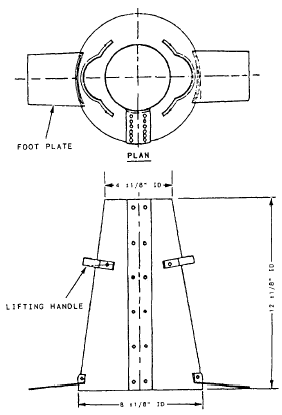|
Slump Tests As you are aware from your study of chapter 7,
WORKABILITY is the relative ease or difficult y
of placing and consolidating concrete. When placed,
all concrete should be as stiff as possible, yet
maintain a homogeneous, voidless mass. Too much
stiffness, however, makes it too difficult or impossible
to work the concrete into the forms and
around reinforcing steel. On the other hand, too
fluid a mixture is also detrimental. The mea-sure of
the workability or consistency of concrete is
its slump, which is a design consideration that is inversely
proportional to the stiffness of the mix. As
shown in table 15-4, the recommended values for
slump vary for different types of construction. To
measure slump, either during the preparation of
concrete trial batches or as a quality control check
during construction, testers perform slump tests.
The procedures for performing slump tests will
be explained later in this chapter.
Strength Tests
In the design of concrete structures, the design engineer
specifies given strengths that the final concrete
products must be capable of attaining. When
trial batches are prepared during mix design or
as a quality control measure to ensure that concrete mixed
or delivered in the field satisfies those specified
strengths, the following tests are performed.
COMPRESSION TEST. Compression
tests are conducted to determine
the compressive strength of
concrete (or its ability to resist a crushing
force). In this test, a standard test load is
applied parallel to the longitudinal axis of a premolded
and properly cured concrete cylinder of
a standard size. When the testis properly con-ducted, a
maximum load is obtained at the point at
which the cylinder ruptures. With this maximum load,
the compressive strength, measured in
pounds per square inch (psi), can be easily calculated.
Although the test procedures will be covered
at the EA2 level, the procedures used to prepare
the cylinders for testing will be discussed later
in this chapter.
FLEXURAL STRENGTH TEST. The
flexural strength (modulus of
rupture) test determines the
flexural strength of concrete (or its ability to resist
a breaking force). In this test, a standard

Figure 15-40.-Slump cone.
to the test load is applied perpendicular longitudinal
axis of a standard size, premolded, and-properly
cured concrete beam. From this test, the
flexural strength, expressed in terms of modulus
of rupture and given in psi, can be readily
calculated. As with the compression test, only
the procedures to prepare the test beams correctly will
be discussed in this TRAMAN.
SLUMP TESTS
The slump test is performed on newly mixed concrete.
To perform the test, you need a slump cone
and a tamping rod. The slump cone (fig. 15-40)
should be made of galvanized steel, 12 in. in
height, with a base opening 8 in. in diameter and
the top opening 4 in. in diameter. Both the top
and bottom openings are perpendicular to the vertical
axis of the cone. The tamping rod is a straight,
steel rod that is 5/8 in. in diameter and approximately
24 in. in length. One end of the rod
is rounded to a diameter of 5/8 in. (Do not substitute
a piece of rebar.)
|


|

